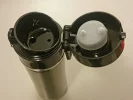BobM
Veteran Member
- Time of past OR future Camino
- V Frances; V Podensis; V Francigena; V Portugues; V Francigena del Sud; Jakobsweg. Jaffa - Jerusalem
I am looking for a good thermos flask to keep about 500ml (1 pint to our American friends) of coffee piping hot for 5 or 6 hours, say, when I want to take a coffee break on the road ( I know the best flask at such times is actually a café, but please bear with me for a moment).
When I asked for a thermos flask in an equipment shop the staff did not know what a thermos flask was and showed me cheap containers with insulation between the double walls that masqueraded as real vacuum flasks.
So, if anyone can point me to a good thermos flask I would sing your praises to the heavens - and drink a toast to you every time I used it.
Bob M
When I asked for a thermos flask in an equipment shop the staff did not know what a thermos flask was and showed me cheap containers with insulation between the double walls that masqueraded as real vacuum flasks.
So, if anyone can point me to a good thermos flask I would sing your praises to the heavens - and drink a toast to you every time I used it.
Bob M
Last edited by a moderator:




























